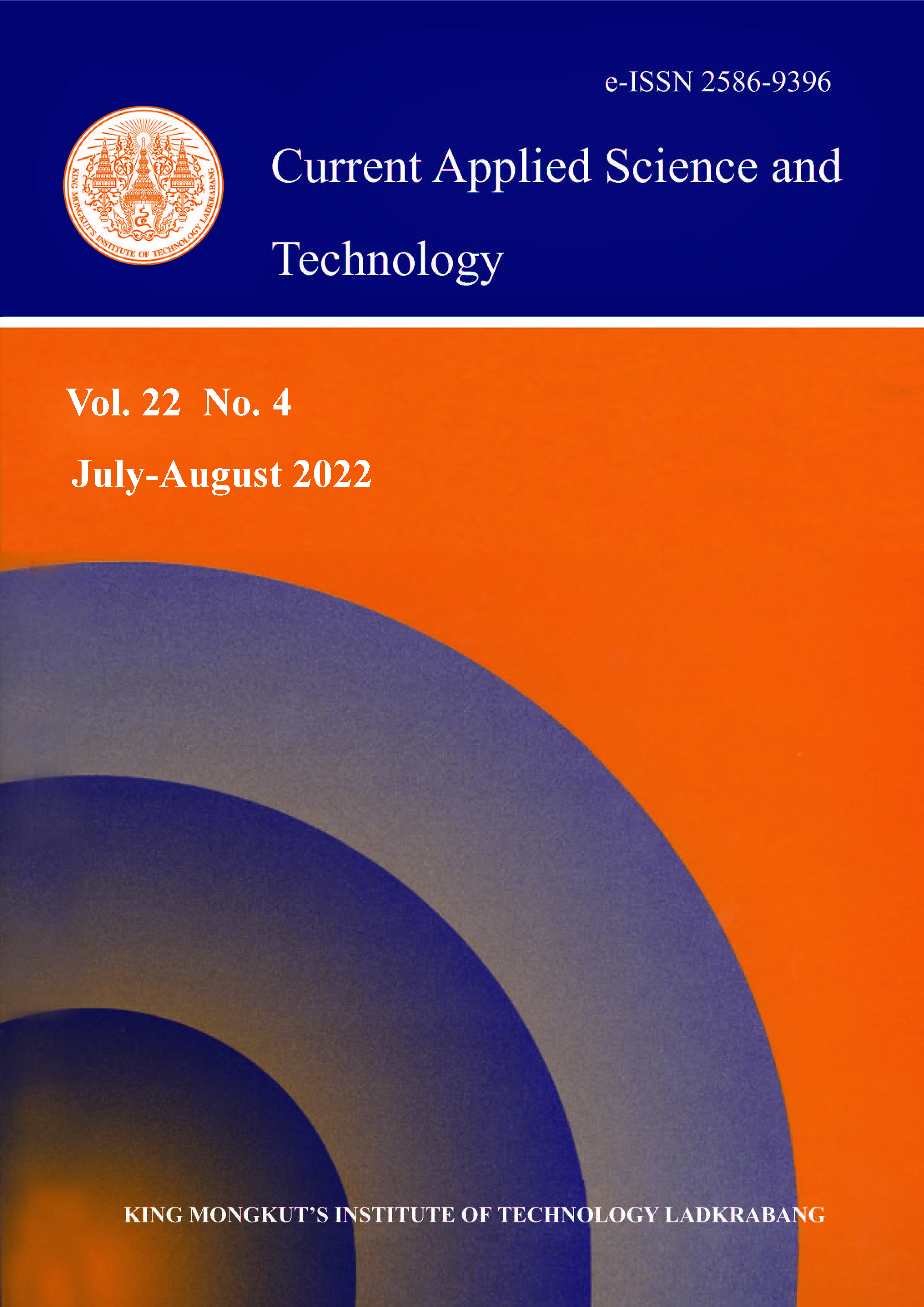Characterization of Riceberry Rice Ice Cream Enriched with Jerusalem Artichoke (Helianthus tuberosus) Extract
Main Article Content
Abstract
Jerusalem artichoke is a good source of inulin, oligofructose, and fructose, which are beneficial to human health. The objectives of this study were to characterize riceberry rice ice cream enriched with Jerusalem artichoke (with emphasis on its physicochemical properties), to assess the functional properties, and to perform sensory evaluation of the enriched ice cream. The ice cream was made from riceberry rice milk, dairy whipping cream, sucrose, and egg yolk. Jerusalem artichoke was used to substitute for the dairy whipping cream and sucrose at 10, 20, and 30% of the total weight. The results indicated that ice cream enriched with Jerusalem artichoke showed optimal physicochemical and functional properties, reduced fat and calorie intake and increased fiber. The overall acceptability scores were highest at 20% level of incorporation. Furthermore, the overrun, viscosity, melting rate, total soluble solids and calorie value were 25.42 ± 1.20%, 50.46 ± 0.40 cP, 0.10 ± 0.01 g/min, 32.60 ± 0.10°Brix and 178.96 Kcal/100g, respectively.
Keywords: fiber; Jerusalem artichoke; ice cream; inulin; riceberry rice
*Corresponding author: Tel.: (+66) 37 217 300 Fax: (+66) 37 217 317
E-mail: jittimon.w@fitm.kmutnb.ac.th
Article Details

This work is licensed under a Creative Commons Attribution-NonCommercial-NoDerivatives 4.0 International License.
Copyright Transfer Statement
The copyright of this article is transferred to Current Applied Science and Technology journal with effect if and when the article is accepted for publication. The copyright transfer covers the exclusive right to reproduce and distribute the article, including reprints, translations, photographic reproductions, electronic form (offline, online) or any other reproductions of similar nature.
The author warrants that this contribution is original and that he/she has full power to make this grant. The author signs for and accepts responsibility for releasing this material on behalf of any and all co-authors.
Here is the link for download: Copyright transfer form.pdf
References
Akalin, A.S., Karagözlü, C. and Ünal, G., 2008. Rheological properties of reduced-fat and low-fat ice cream containing whey protein isolate and inulin. European Food Research and Technology, 227(3), 889-895.
Marshall, R.T., Goff, H.D. and Hartel, R.W., 2003. Ice Cream. 6th ed. New York: Kluwer/Plenum Publishers.
Devereux, H.M., Jones, G.P., McCormack, L. and Hunter, W.C., 2003. Consumer acceptability of low-fat foods containing inulin and oligofructose. Journal of Food Science, 68, 1850-1854.
El-Kholy, W.M. and Mahrous, H., 2015. Biological studies on bio-yoghurt fortified with prebiotic obtained from Jerusalem artichoke. Food and Nutrition Sciences, 6(16), 1552-1564.
Roberfroid, M.B., 2005. Introducing inulin-type fructans. British Journal of Nutrition, 93(1), 13-25.
Chavan, R.S., Khedkar, C.D. and Bhatt, S., 2016. Fat replacer. In: B. Caballero, P. Finglas and F. Toledra, eds. Encyclopedia of Food and Health. London: Academic Press, pp. 589-595.
Ozgoren, E., Isik, F. and Yapar, A., 2019. Effect of Jerusalem artichoke (Helianthus tuberosus L.) supplementation on chemical and nutritional properties of crackers. Journal of Food Measurement and Characterization, 13(4), 2812-2821.
Jangmesin, K., Rimkeeree, H. and Tadakittisarn, S., 2017. Enzymatic optimization of riceberry bran protein hydrolysate extraction and characterization. Current Applied Science and Technology, 17(2), 209-223.
Kemsawasd, V. and Chaikham, P., 2020. Effects of frozen storage on viability of probiotics and antioxidant capacities of synbiotic riceberry and sesame-riceberry milk ice creams. Current Research in Nutrition and Food Science, 8(1), 107-121.
Akbari, M., Eskandari, M. H., Niakosari, M. and Bedeltavana, A., 2016. The effect of inulin on the physicochemical properties and sensory attributes of low-fat ice cream. International Dairy Journal, 57, 52-55.
FOSS Analytical, 2010. AN 3437: Determination of crude fiber according to EN ISO 6865:2000 and 92/89/EEC. In: FOSS Application Notes for Fibertec™ 2010 and Fibertec™ 1020 M6. Hilleroed: Foss Analytical.
Saengkanuk, A., Nuchadamrong, S., Jogloy, S., Patanothia, A. and Srijaranai, S., 2011. A simplified spectrophotpmetric method for determination of inulin in Jerusalem artichoke (Helianthus tuberosus L.) tubers. European Food Research and Technology, 233, 6009-6016.
A.O.A.C., 2000. Official Methods of Analysis. 17th ed. Arlington: The Association of Official Analytical Chemists.
Rinaldi, M., Dall’Asta, C., Paciulli, M., Guizzetti, S., Barbanti, D. and Chiavaro, E., 2014. Innovation in the Italian ice cream production: Effect of different phospholipid emulsifiers. Dairy Science and Technology, 94, 33-49.
Criscio, T.D., Fratianni, A., Mignogna, R., Cinquanta, L., Coppola, R., Sorrentino, E. and Panfili, G., 2010. Production of functional probiotic, prebiotic, and synbiotic ice creams. Journal of Dairy Science, 93(10), 4555-4564.
Khan, S., Rustagi, S., Choudhary, S., Pandey, A., Khan, M. K., Kumari, A. and Singh, A., 2018. Sucralose and maltodextrin-an alternative to low fat sugar free ice-cream. Bioscience Biotechnology Research Communications, 11(1), 136-143.
Darwish, A.S.M., Elkot, F.W. and Mohamed, O.R., 2012. Functional properties and nutritional quality of ice cream enriched with Jerusalem artichoke flour. Journal of Agroalimentary Processes and Technologies, 22(2), 87-94.
Syed, Q.A., Anwar, S., Shukat, R. and Zahoor, T., 2018. Effects of different ingredients on texture of ice cream. Journal of Nutritional Health and Food Engineering, 8(6), 422-435.
Akin, M.B., Akin, M.S. and Kirmaci, Z., 2007. Effects of inulin and sugar levels on the viability of yogurt and probiotic bacteria and the physical and sensory characteristics in probiotic ice-cream. Food Chemistry, 104, 93-99.






